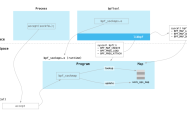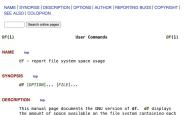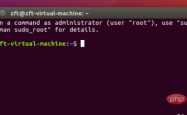Linux文件查找命令总结(下篇)
前言
关于Linux文件查找命令总结我们分别介绍了which命令、whereis命令、locate命令、find命令这四个命令,本篇向大家介绍的是find命令。
find 命令的参数详解
find一些常用参数的一些常用实例和一些具体用法和注意事项。
使用name选项
文件名选项是find命令最常用的选项,要么单独使用该选项,要么和其他选项一起使用。
可以使用某种文件名模式来匹配文件,记住要用引号将文件名模式引起来。
不管当前路径是什么,如果想要在自己的根目录 H O M E 中 查 找 文 件 名 符 合 ∗ . l o g 的 文 件 , 使 用 作 为 ′ p a t h n a m e ′ 参 数 , 波 浪 号 代 表 了 你 的 HOME中查找文件名符合*.log的文件,使用~作为 'pathname'参数,波浪号~代表了你的 HOME中查找文件名符合∗.log的文件,使用 作为′pathname′参数,波浪号 代表了你的HOME目录。
?| 1 | find ~ -name "*.log" -print |
想要在当前目录及子目录中查找所有的‘ *.log‘文件,可以用:
?| 1 | find . -name "*.log" -print |
想要的当前目录及子目录中查找文件名以一个大写字母开头的文件,可以用:
?| 1 | find . -name "[A-Z]*" -print |
想要在/etc目录中查找文件名以host开头的文件,可以用:
?| 1 | find /etc -name "host*" -print |
想要查找$HOME目录中的文件,可以用:
?| 1 | find ~ -name "*" -print 或 find . -print |
要想让系统高负荷运行,就从根目录开始查找所有的文件。
?| 1 | find / -name "*" -print |
如果想在当前目录查找文件名以一个个小写字母开头,最后是4到9加上.log结束的文件:
命令:
?| 1 | find . -name "[a-z]*[4-9].log" -print |
输出:
?| 1 2 3 4 5 6 7 8 9 10 11 12 13 14 15 16 17 18 19 20 21 22 23 24 25 26 27 | [root@localhost test ] # ll 总计 316 -rw-r--r-- 1 root root 302108 11-13 06:03 log2012.log -rw-r--r-- 1 root root 61 11-13 06:03 log2013.log -rw-r--r-- 1 root root 0 11-13 06:03 log2014.log -rw-r--r-- 1 root root 0 11-13 06:06 log2015.log drwxr-xr-x 6 root root 4096 10-27 01:58 scf drwxrwxr-x 2 root root 4096 11-13 06:08 test3 drwxrwxr-x 2 root root 4096 11-13 05:50 test4 [root@localhost test ] # find . -name "[a-z]*[4-9].log" -print . /log2014 .log . /log2015 .log . /test4/log2014 .log [root@localhost test ] # |
用perm选项
按照文件权限模式用-perm选项,按文件权限模式来查找文件的话。
最好使用八进制的权限表示法。
如在当前目录下查找文件权限位为755的文件,即文件属主可以读、写、执行,其他用户可以读、执行的文件,可以用:
?| 1 2 3 4 5 6 7 8 9 10 11 12 13 14 15 16 17 18 19 20 21 | [root@localhost test ] # find . -perm 755 -print . . /scf . /scf/lib . /scf/service . /scf/service/deploy . /scf/service/deploy/product . /scf/service/deploy/info . /scf/doc . /scf/bin [root@localhost test ] # |
还有一种表达方法:在八进制数字前面要加一个横杠-,表示都匹配,如-007就相当于777,-005相当于555,
命令:
?| 1 | find . -perm -005 |
输出:
?| 1 2 3 4 5 6 7 8 9 10 11 12 13 14 15 16 17 18 19 20 21 22 23 24 25 26 27 28 29 30 31 32 33 34 35 36 37 38 39 40 41 42 43 | [root@localhost test ] # ll 总计 316 -rw-r--r-- 1 root root 302108 11-13 06:03 log2012.log -rw-r--r-- 1 root root 61 11-13 06:03 log2013.log -rw-r--r-- 1 root root 0 11-13 06:03 log2014.log -rw-r--r-- 1 root root 0 11-13 06:06 log2015.log drwxr-xr-x 6 root root 4096 10-27 01:58 scf drwxrwxr-x 2 root root 4096 11-13 06:08 test3 drwxrwxr-x 2 root root 4096 11-13 05:50 test4 [root@localhost test ] # find . -perm -005 . . /test4 . /scf . /scf/lib . /scf/service . /scf/service/deploy . /scf/service/deploy/product . /scf/service/deploy/info . /scf/doc . /scf/bin . /test3 [root@localhost test ] # |
忽略某个目录
如果在查找文件时希望忽略某个目录,因为你知道那个目录中没有你所要查找的文件,那么可以使用-prune选项来指出需要忽略的目录。
在使用-prune选项时要当心,因为如果你同时使用了-depth选项,那么-prune选项就会被find命令忽略。
如果希望在test目录下查找文件,但不希望在test/test3目录下查找,可以用:
命令:
?| 1 | find test -path "test/test3" -prune -o -print |
输出:
?| 1 2 3 4 5 6 7 8 9 10 11 12 13 14 15 16 17 18 19 20 21 22 23 24 25 26 27 28 29 30 31 32 33 34 35 36 37 | [root@localhost soft] # find test -path "test/test3" -prune -o -print test test /log2014 .log test /log2015 .log test /test4 test /test4/log2014 .log test /test4/log2013 .log test /test4/log2012 .log test /scf test /scf/lib test /scf/service test /scf/service/deploy test /scf/service/deploy/product test /scf/service/deploy/info test /scf/doc test /scf/bin test /log2013 .log test /log2012 .log [root@localhost soft] # |
使用find查找文件的时候怎么避开某个文件目录
在test 目录下查找不在test4子目录之内的所有文件
命令:
?| 1 | find test -path "test/test4" -prune -o -print |
输出:
?| 1 2 3 4 5 6 7 8 9 10 11 12 13 14 15 16 17 18 19 20 21 22 23 24 25 26 27 28 29 30 31 32 33 34 35 36 37 38 39 40 41 42 43 44 45 46 47 48 49 50 51 52 53 54 55 56 57 58 59 60 61 62 63 64 65 66 67 68 69 | [root@localhost soft] # find test test test /log2014 .log test /log2015 .log test /test4 test /test4/log2014 .log test /test4/log2013 .log test /test4/log2012 .log test /scf test /scf/lib test /scf/service test /scf/service/deploy test /scf/service/deploy/product test /scf/service/deploy/info test /scf/doc test /scf/bin test /log2013 .log test /log2012 .log test /test3 [root@localhost soft] # find test -path "test/test4" -prune -o -print test test /log2014 .log test /log2015 .log test /scf test /scf/lib test /scf/service test /scf/service/deploy test /scf/service/deploy/product test /scf/service/deploy/info test /scf/doc test /scf/bin test /log2013 .log test /log2012 .log test /test3 [root@localhost soft] # |
说明:
find [-path …] [expression]
在路径列表的后面的是表达式
-path “test” -prune -o -print 是 -path “test” -a -prune -o -print 的简写表达式按顺序求值, -a 和 -o 都是短路求值,与 shell 的 && 和 || 类似如果
-path “test” 为真,则求值 -prune , -prune 返回真,与逻辑表达式为真;
否则不求值 -prune,与逻辑表达式为假。如果 -path “test” -a -prune 为假,则求值 -print ,-print返回真,或逻辑表达式为真;
否则不求值 -print,或逻辑表达式为真。
这个表达式组合特例可以用伪码写为:
if -path “test” then
-prune
else
避开多个文件夹:
命令:
?| 1 | find test \( -path test /test4 -o -path test /test3 \) -prune -o -print |
输出:
?| 1 2 3 4 5 6 7 8 9 10 11 12 13 14 15 16 17 18 19 20 21 22 23 24 25 26 27 28 29 | [root@localhost soft] # find test \( -path test/test4 -o -path test/test3 \) -prune -o -print test test /log2014 .log test /log2015 .log test /scf test /scf/lib test /scf/service test /scf/service/deploy test /scf/service/deploy/product test /scf/service/deploy/info test /scf/doc test /scf/bin test /log2013 .log test /log2012 .log [root@localhost soft] # |
说明:
圆括号表示表达式的结合。 \ 表示引用,即指示 shell 不对后面的字符作特殊解释,而留给 find 命令去解释其意义。
查找某一确定文件,-name等选项加在-o 之后
命令:
?| 1 | find test \(-path test /test4 -o -path test /test3 \) -prune -o -name "*.log" -print |
输出:
?| 1 2 3 4 5 6 7 8 9 10 11 | [root@localhost soft] # find test \( -path test/test4 -o -path test/test3 \) -prune -o -name "*.log" -print test /log2014 .log test /log2015 .log test /log2013 .log test /log2012 .log [root@localhost soft] # |
使用user和nouser选项
按文件属主查找文件:
在$HOME目录中查找文件属主为peida的文件
命令:
?| 1 | find ~ -user peida -print |
在/etc目录下查找文件属主为peida的文件
命令:
?| 1 | find /etc -user peida -print |
说明:
为了查找属主帐户已经被删除的文件,可以使用-nouser选项。在/home目录下查找所有的这类文件
命令:
?| 1 | find /home -nouser -print |
说明:
这样就能够找到那些属主在/etc/passwd文件中没有有效帐户的文件。
在使用-nouser选项时,不必给出用户名; find命令能够为你完成相应的工作。
使用group和nogroup选项
就像user和nouser选项一样,针对文件所属于的用户组, find命令也具有同样的选项,为了在/apps目录下查找属于gem用户组的文件,可以用:
?| 1 | find /apps -group gem -print |
要查找没有有效所属用户组的所有文件,可以使用nogroup选项。
下面的find命令从文件系统的根目录处查找这样的文件:
?| 1 | find / -nogroup-print |
按照更改时间或访问时间等查找文件
如果希望按照更改时间来查找文件,可以使用mtime,atime或ctime选项。
如果系统突然没有可用空间了,很有可能某一个文件的长度在此期间增长迅速,这时就可以用mtime选项来查找这样的文件。
用减号-来限定更改时间在距今n日以内的文件,而用加号+来限定更改时间在距今n日以前的文件。
希望在系统根目录下查找更改时间在5日以内的文件,可以用:
?| 1 | find / -mtime -5 -print |
为了在/var/adm目录下查找更改时间在3日以前的文件,可以用:
?| 1 | find /var/adm -mtime +3 -print |
查找比某个文件新或旧的文件
如果希望查找更改时间比某个文件新但比另一个文件旧的所有文件,可以使用-newer选项。
它的一般形式为:
?| 1 | newest_file_name ! oldest_file_name |
其中,!是逻辑非符号。
查找更改时间比文件log2012.log新但比文件log2017.log旧的文件
命令:
?| 1 | find -newer log2012.log ! -newer log2017.log |
输出:
?| 1 2 3 4 5 6 7 8 9 10 11 12 13 14 15 16 17 18 19 20 21 22 23 24 25 26 27 28 29 30 31 32 33 34 35 | [root@localhost test ] # ll 总计 316 -rw-r--r-- 1 root root 302108 11-13 06:03 log2012.log -rw-r--r-- 1 root root 61 11-13 06:03 log2013.log -rw-r--r-- 1 root root 0 11-13 06:03 log2014.log -rw-r--r-- 1 root root 0 11-13 06:06 log2015.log -rw-r--r-- 1 root root 0 11-16 14:41 log2016.log -rw-r--r-- 1 root root 0 11-16 14:43 log2017.log drwxr-xr-x 6 root root 4096 10-27 01:58 scf drwxrwxr-x 2 root root 4096 11-13 06:08 test3 drwxrwxr-x 2 root root 4096 11-13 05:50 test4 [root@localhost test ] # find -newer log2012.log ! -newer log2017.log . . /log2015 .log . /log2017 .log . /log2016 .log . /test3 [root@localhost test ] # |
查找更改时间在比log2012.log文件新的文件
命令:
?| 1 | find . -newer log2012.log -print |
输出:
?| 1 2 3 4 5 6 7 8 9 10 11 12 13 | [root@localhost test ] # find -newer log2012.log . . /log2015 .log . /log2017 .log . /log2016 .log . /test3 [root@localhost test ] # |
使用type选项
在/etc目录下查找所有的目录
命令:
?| 1 | find /etc - type d -print |
在当前目录下查找除目录以外的所有类型的文件
命令:
find . ! -type d -print
在/etc目录下查找所有的符号链接文件
命令:
?| 1 | find /etc - type l -print |
使用size选项
可以按照文件长度来查找文件,这里所指的文件长度既可以用块(block)来计量,也可以用字节来计量。
以字节计量文件长度的表达形式为N c;以块计量文件长度只用数字表示即可。
在按照文件长度查找文件时,一般使用这种以字节表示的文件长度,在查看文件系统的大小,因为这时使用块来计量更容易转换。
在当前目录下查找文件长度大于1 M字节的文件
命令:
?| 1 | find . -size +1000000c -print |
在/home/apache目录下查找文件长度恰好为100字节的文件
命令:
?| 1 | find /home/apache -size 100c -print |
在当前目录下查找长度超过10块的文件(一块等于512字节)
命令:
?| 1 | find . -size +10 -print |
使用depth选项
在使用find命令时,可能希望先匹配所有的文件,再在子目录中查找。
使用depth选项就可以使find命令这样做。这样做的一个原因就是,当在使用find命令向磁带上备份文件系统时,希望首先备份所有的文件,其次再备份子目录中的文件。
find命令从文件系统的根目录开始,查找一个名为CON.FILE的文件
命令:
?| 1 | find / -name "CON.FILE" -depth -print |
说明:
它将首先匹配所有的文件然后再进入子目录中查找
使用mount选项
在当前的文件系统中查找文件(不进入其他文件系统),可以使用find命令的mount选项。
从当前目录开始查找位于本文件系统中文件名以XC结尾的文件
命令:
?| 1 | find . -name "*.XC" - mount -print |
到此这篇关于Linux文件查找命令总结(下篇)的文章就介绍到这了,相关内容请搜索服务器之家以前的文章或继续浏览下面的相关文章希望大家以后多多支持服务器之家!
原文链接:https://blog.csdn.net/qq_41854911/article/details/122396781
1.本站遵循行业规范,任何转载的稿件都会明确标注作者和来源;2.本站的原创文章,请转载时务必注明文章作者和来源,不尊重原创的行为我们将追究责任;3.作者投稿可能会经我们编辑修改或补充。











